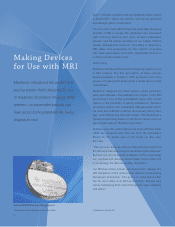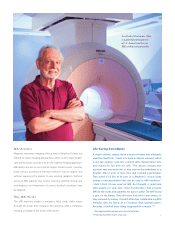Medtronic 2010 Annual Report Download - page 20
Download and view the complete annual report
Please find page 20 of the 2010 Medtronic annual report below. You can navigate through the pages in the report by either clicking on the pages listed below, or by using the keyword search tool below to find specific information within the annual report.
Currently, healthcare providers are paid under separate fee-
for-service payment systems that reward volume of services.
Many experts believe that higher-quality, lower-cost health-
care demands new payment systems that reward coordi-
nated care. For example, combining payments for doctors,
hospitals, and other post-acute care providers into bundled
payments could create incentives for more coordinated
treatment following hospitalization and improved patient
outcomes.
To help develop possible bundled payment solutions, we’re
analyzing the same data and methodologies that payers
like Medicare use when they develop coverage and
payment policies. We’ll use our results to recommend
bundled payment structures that encourage high-quality,
coordinated care and ensure appropriate access to device-
based therapies.
We’re also using economic data to create cost-effectiveness
models that reflect local environments. For example, we
developed a cost-effectiveness model evaluating spinal
cord stimulation (SCS) for the treatment of failed back
surgery syndrome to gain coverage in the United Kingdom.
The model, which was validated by the National Institute of
Health and Clinical Excellence (NICE), found SCS in combi-
nation with medical management provides good value
for the money compared to medical management alone.
Currently, we’re using economic data from U.S. payers to
adapt the SCS model to reflect the U.S. healthcare envi-
ronment and demonstrate the therapy’s value in the
U.S. population.
By playing a more active role in shaping payment policy and
enhancing our ability to demonstrate the value of our thera-
pies, we’re helping ensure society has the highest-quality,
most-efficient healthcare systems possible.
Demonstrating
Economic Value
With accelerating focus on the economic
value of medical therapies, Medtronic is
developing innovative approaches to
demonstrate the value of our products
and therapies.
We recently established a Health Economics Center of
Excellence, comprising internal and external health eco-
nomic experts from around the globe. This virtual team is
evaluating the value of our therapies and working to shape
payment policy innovations.
With U.S. healthcare reform, there’s increasing demand to
develop new methods of paying providers that both reward
improvements in quality of care and lower costs.
Through our new Health Economics Center of Excellence, we’re working to demonstrate the value of our innovative therapies, such as the RestoreULTRA
neurostimulator for chronic back and leg pain (left), Valiant Captivia thoracic stent graft system* (center), and Paradigm Veo insulin pump system.*
* Not cleared/approved for marketing in the United States.
16
























